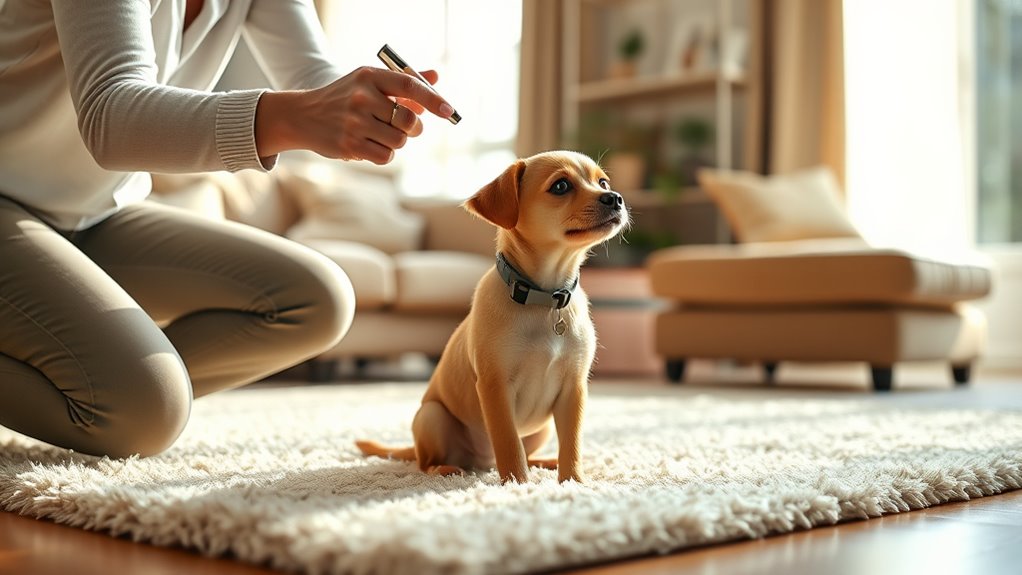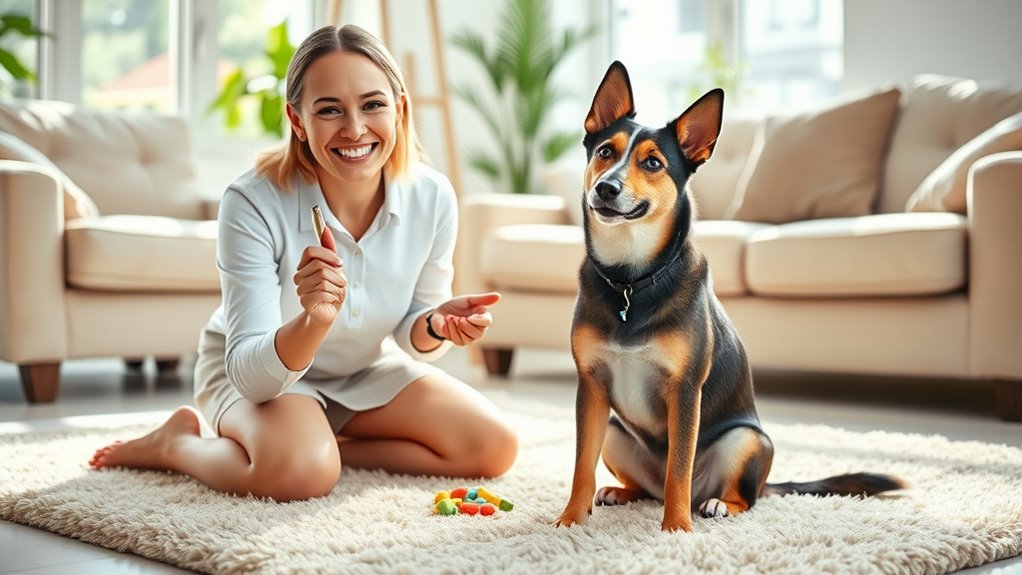To start clicker training, select a clear, reliable clicker and pair it with treats to build a positive association. Use a consistent cue and click immediately when your pet performs the desired behavior. Keep sessions short, fun, and reward generously to reinforce learning. Focus on timing and patience, addressing challenges with repetition and clear cues. By maintaining a positive environment and routine, you’ll help your pet learn effectively—stay tuned for more tips to perfect your training skills.
Key Takeaways
- Start training in a quiet, distraction-free environment to help your pet focus and build a positive association with the clicker.
- Pair the clicker with treats immediately to establish a clear link between the sound and rewards.
- Use consistent cues and click immediately when the desired behavior occurs for effective reinforcement.
- Keep training sessions short, positive, and frequent to maintain motivation and reinforce learning.
- Be patient, reinforce good behavior consistently, and gradually introduce cues to build complex behaviors.
Understanding the Principles of Clicker Training

Understanding the principles of clicker training is essential before you start working with your pet. At its core, this method relies on behavior reinforcement through positive conditioning. When your pet performs a desired behavior, you immediately use the clicker to mark that action, creating a clear connection between the behavior and a positive outcome. The sound of the click serves as a consistent, neutral signal that a reward is coming, which helps your pet understand exactly what you want. This approach encourages your pet to repeat behaviors that lead to the click and treat, strengthening their learning process. By focusing on positive reinforcement, you build trust and motivation, making training enjoyable and effective for both of you. Fokos also emphasizes the importance of consistent timing to reinforce learning effectively. Additionally, understanding key traits of successful trainers can significantly improve your training outcomes. Recognizing the importance of timing and consistency ensures your pet clearly associates the click with the desired behavior, which is fundamental in effective training. Incorporating knowledge of animal behavior can further enhance your ability to train effectively and build a stronger bond with your pet.
Essential Equipment and Supplies

Choosing the right clicker is key; look for one that feels comfortable and produces a clear sound. You might also consider supplementary tools like treat bags or target sticks to enhance your training sessions. Having these essentials ready will set a solid foundation for your clicker training journey. Additionally, understanding color accuracy and how it impacts visual feedback can help you better interpret your pet’s responses and improve training outcomes. Being aware of cookie preferences can also ensure your training setup respects your privacy choices and maintains a smooth experience. Incorporating positive reinforcement techniques can further strengthen your training effectiveness and foster a trusting relationship with your pet. Moreover, staying informed about AI advancements in training tools can help you select innovative equipment that enhances your training process.
Clicker Selection Tips
Selecting the right clicker is essential for effective training, so you’ll want a device that’s reliable, easy to use, and comfortable to hold. Focus on clicker durability to guarantee it withstands frequent use and weather conditions. Consider sound options—some clickers have louder or quieter sounds, which can help you find one that suits your environment and your pet’s sensitivity.
Here are some tips:
- Choose a clicker with a sturdy, high-quality build for longevity.
- Test different sound levels to match your training setting.
- Opt for an ergonomic design that fits comfortably in your hand.
- Select a compact size for easy handling and portability.
Supplementary Training Tools
Having the right supplementary training tools can substantially enhance your pet’s learning process. These tools support novel training methods and provide alternative reinforcement options, making training more effective and engaging. Essential supplies include treat bags, clicker pouches, and target sticks. Using varied tools keeps your pet interested and helps reinforce behaviors through different stimuli. Incorporating training tools that are suited to your pet’s preferences can also improve overall training success. Additionally, selecting tools that promote consistent reinforcement can help solidify desired behaviors more efficiently. Considering positive reinforcement techniques can further boost your training outcomes and foster a trusting bond with your pet.
How to Introduce the Clicker to Your Pet

Start in a quiet spot where your pet feels comfortable, so they can focus on the clicker. Use a consistent cue, like “Yes,” every time you click, to build understanding. Pair the click with treats to help your pet connect the sound with positive reinforcement. Incorporating training tools like the clicker can enhance your pet’s learning process and effectiveness. Ensuring proper safety measures during training will help prevent accidental over-stimulation or stress for your pet. Being aware of ethical considerations in training approaches can support a positive and fair learning environment.
Choose a Quiet Spot
To introduce the clicker effectively, choose a quiet spot where your pet can focus without distractions. A calm environment helps your pet associate the click with positive behavior. Consider these tips:
- Pick a space with minimal noise distractions, away from barking dogs or loud appliances.
- Ensure the ambient lighting is soft and consistent, avoiding sudden changes that might startle your pet.
- Use an area where your pet feels comfortable and relaxed.
- Keep the environment free of other stimuli that could divert their attention during training.
- Creating a dedicated training space helps your pet focus on the clicker and builds a strong connection between the sound and rewards. Establishing a predictable environment can also reduce auditory sensitivities that may interfere with training sessions. Incorporating automation in training routines can further enhance consistency and effectiveness, especially for busy pet owners. Creating a calm training environment makes training sessions more effective and enjoyable.
Use a Consistent Cue
How can you guarantee your pet understands that the click signals a reward? The key is cue consistency. Use the same word, sound, or gesture every time you want your pet to associate the click with a specific behavior. This training clarity helps prevent confusion and speeds up learning. Avoid changing cues or using different signals for the same command, as this can slow progress and create uncertainty. When your pet hears the cue, click immediately upon correct behavior, reinforcing the connection. Consistent cues build a clear, reliable communication channel between you and your pet. Remember, the goal is to make your cues predictable so your pet quickly understands what earns a click and reward. This consistency is essential for effective clicker training. Additionally, aligning your training approach with Law of Attraction principles can help foster a positive and focused learning environment for your pet. Practicing patience and positive reinforcement further strengthens this training bond, making the learning process more enjoyable for both of you. Establishing training consistency ensures your pet remains engaged and responsive throughout your sessions. Incorporating payment processing techniques, such as timely rewards and clear signals, can also enhance your training effectiveness.
Pair With Treats
Introducing the clicker to your pet involves pairing it with treats so they associate the sound with positive reinforcement. This treat pairing helps establish a reward association, making the clicker a powerful training tool. To do this effectively:
- Click the device once, then immediately give your pet a treat.
- Repeat several times to reinforce the connection between the click and a reward.
- Keep sessions short and positive to maintain your pet’s interest.
- Gradually introduce cues after the click, strengthening the reward association.
- Using a clicker training method can improve your pet’s learning efficiency and responsiveness. Incorporating behavioral conditioning principles can further enhance training outcomes and foster better understanding between you and your pet.
- Consistency and patience are key to helping your pet reliably link the click with positive experiences, especially when using positive reinforcement. Understanding how training tools work can help you optimize your training sessions and achieve better results.
Timing and Marking the Right Behavior

Timing is crucial in clicker training because it helps your dog understand exactly which behavior you’re rewarding. Achieving good timing accuracy ensures your dog connects the specific action with the click and treat. If your timing is off, your dog may become confused about which behavior earned the reward, slowing down progress. To improve behavior recognition, watch your dog closely and click immediately when the desired behavior occurs. This instant response reinforces the behavior clearly and effectively. Being precise with your timing makes the training more efficient and helps your dog learn faster. Remember, the key is to click at the exact moment your dog performs the right behavior, strengthening their understanding and increasing the chances of repeating it.
Reinforcing Good Behavior Effectively

Once you’ve clicked and marked the right behavior, the next step is to reinforce that behavior effectively. Using positive reinforcement encourages your pet to repeat good actions and helps shape their behavior over time. To do this well:
- Deliver rewards immediately after the desired behavior to strengthen the connection.
- Keep rewards consistent to build reliable behavior shaping.
- Use a variety of rewards to maintain engagement and motivation.
- Be patient and avoid over-rewarding, ensuring your pet values each reinforcement.
Common Challenges and How to Overcome Them

While clicker training is effective, you may encounter common challenges like your pet’s initial hesitation or inconsistent responses. Behavioral setbacks can happen when your pet doesn’t immediately understand the cues or gets distracted. To overcome this, be patient and keep training sessions short, focusing on positive reinforcement. Inconsistent cues often cause confusion, so guarantee your signals are clear and consistent every time. Practice using the same tone, gestures, and timing. If your pet hesitates or seems unsure, review the basics and reintroduce commands gradually. Remember, setbacks are normal; they’re part of the learning process. Stay patient, consistent, and positive, and your pet will gradually overcome these challenges and respond more reliably to your cues.
Building a Training Schedule and Setting Goals

After addressing common training challenges, the next step is to create a consistent routine that keeps your pet engaged and progressing. A well-structured training schedule helps establish habits and reinforces learning. To set effective goals, consider what behaviors you want to achieve and break them into manageable steps. Here’s how to get started:
- Determine how often you’ll train each day.
- Set specific, measurable goals for each session.
- Allocate time for review and reinforcement.
- Adjust your training schedule based on progress and setbacks.
Tips for Maintaining Motivation and Engagement

Keeping your pet motivated and engaged during clicker training can be challenging, but with the right strategies, you can make sessions enjoyable and effective. One key tip is to maintain reward consistency; always reward desired behaviors promptly to reinforce learning. This helps your pet understand exactly what actions earn praise or treats. Additionally, patience strategies are essential—if progress slows, stay calm and avoid frustration. Break training into short, frequent sessions to prevent boredom and keep your pet interested. Celebrate small victories and avoid rushing through exercises. By staying consistent with rewards and practicing patience, you’ll foster a positive learning environment that keeps your pet motivated and enthusiastic to participate. This approach builds trust and ensures training remains a fun, rewarding experience for both of you.
Expanding Your Training Skills and Techniques

Building on your success in maintaining motivation and engagement, you can now focus on expanding your training skills and techniques to achieve even better results. To do this, explore advanced shaping, where you gradually refine behaviors with precise cues. Additionally, practice behavior chaining by linking simple actions into complex sequences, making training more efficient. Here are four ways to expand your skills:
- Break complex behaviors into smaller steps using advanced shaping.
- Use behavior chaining to teach multi-step routines.
- Increase difficulty gradually to challenge your pet without frustration.
- Record progress to fine-tune your techniques and recognize improvements.
Frequently Asked Questions
Can Clicker Training Work With All Types of Pets?
You might wonder if clicker training works with all types of pets. While species adaptability varies, most animals can learn with this method, but there are training limitations. Some species respond quicker, like dogs and cats, while others, like reptiles, may need different approaches. You can try clicker training, but be patient and adapt techniques to suit each pet’s unique needs, ensuring successful learning experiences.
How Long Does It Typically Take to See Results?
Results vary depending on your pet and training consistency, but you can usually see progress within a few days to weeks. Patience requirements are key, as animals learn at different rates. Staying consistent with your cues and rewards helps reinforce good behavior, speeding up the process. Keep practicing regularly, and don’t get discouraged if progress seems slow—your patience and persistence will pay off over time.
Is Clicker Training Suitable for Aggressive Animals?
You might wonder if clicker training is suitable for aggressive animals. It can be effective for aggression management and behavior modification when used correctly. By reinforcing calm, desired behaviors with the clicker, you help your pet learn appropriate responses. However, patience and consistency are key. Always combine clicker training with professional guidance if aggression is severe, ensuring a safe and positive experience for both you and your animal.
What Should I Do if My Pet Ignores the Clicker?
When your pet ignores the clicker, it’s a coincidence that patience strategies and positive reinforcement come into play. You should start by ensuring the click is clearly associated with a reward, using consistent timing. Practice patience, repeat sessions in a quiet environment, and keep sessions short. With time, your pet will learn to associate the click with good things, making training more effective and enjoyable for both of you.
Are There Any Health Risks Associated With Clicker Training?
You might wonder if clicker safety poses any risks to your pet’s health. Generally, clicker training is safe when you use a device designed for pets and avoid overly loud or harsh sounds. Be mindful of your pet’s reactions and stop if they seem distressed. Proper training and gentle handling guarantee your pet’s health isn’t compromised, making clicker training a safe and effective way to bond and teach your furry friend.
Conclusion
With patience and consistency, your clicker training journey will bloom like a well-tended garden. Remember, every click is a stepping stone toward building trust and understanding with your pet. Stay motivated, embrace challenges as learning opportunities, and celebrate small victories along the way. As you nurture these skills, you’ll find that training becomes not just a task, but a beautiful dance of communication, strengthening your bond and revealing your pet’s full potential.










